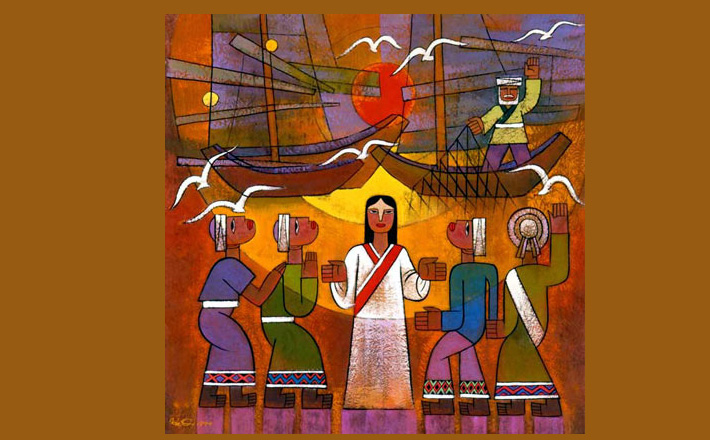Commentary on John 1:43-51
This text tells how it works: The Christian faith is passed from person to person. That’s how it started with Jesus, and that’s how it’s been for 2,000-plus years.
What was it about Jesus that caused people to believe in him and follow him with no evidence? We don’t know. Some might remember the old radio program “The Greatest Story Ever Told.” The appearance of Jesus was dressed up with music, so that before he spoke you heard violins in the background. Most assuredly that did not really happen. Jesus didn’t need background music to impress people. There was something about him that drew people to him.
Had Philip and Nathanael known him before? Had Philip heard about him from Andrew and Peter, since they lived in the same town? The text doesn’t say. It only says that Philip followed Jesus straightaway, then told Nathanael that “we” had found the one promised in the Old Testament. Was the “we” Philip spoke of other people who were following Jesus? We don’t know.
When Nathanael expressed skepticism about anything good coming out of Jesus’ hometown of Nazareth, Philip simply says, “Come and see for yourself.” When Jesus tells Nathanael that he saw him already Nathanael is so impressed that he impetuously calls him the “Son of God” and the “King of Israel.”
What was there about Jesus to have this kind of effect on people? The New Testament gives us a slight hint. The Sermon on the Mount in Matthew concludes with the observation, “for he taught them as one having authority, and not as their scribes,” a phrase repeated in the other gospels (Matthew 7:29, also Mark 1:22, Luke 4:32,36, John 5:27 and others).
Without doubt there was something about Jesus that drew people to him. When British biblical scholar J.B. Phillips translated the Gospels, he was struck by the personality of Jesus and how he drew others to himself. He concluded that there must have been something extraordinary about his person that affected those with whom he came into contact. He described his own reaction in his 1967 book Ring of Truth, that there must have been something magnetic about Jesus’ personality to have such an immediate effect on people.
Read the Gospels and note the profound effect Jesus has when he meets people: the Canaanite woman (Matthew 15:21-28), the blind man at Bethsaida (Mark 8:22-26), the Roman centurion (Luke 7:1-10), the woman at the Pharisee’s home (Luke 7:36-50), Zacchaeus (Luke 19:1-10), the woman at the well (John 4), the sick man at the Bethesda pool (John 5:1-9), the thief crucified next to Jesus (Luke 23:40-43), and the centurion at the foot of the cross (Mark 15:39, Luke 23:47) — to name only a few.
People meet Jesus, and they are changed. Whatever their deepest need was, Jesus meets it. Then they tell others what happened.
And that’s how it has worked ever since. One person says to another, “I follow Jesus and invite you to do so too.” Later on as the church grows, parents bring their infant children to Jesus in baptism and then bring them up to follow him.
It’s always person-to-person.
Follow the story throughout the New Testament. An Ethiopian eunuch is puzzled by a passage in the Old Testament, and Philip “proclaimed to him the good news about Jesus” (Acts 8:35). Peter went to the household of the Roman centurion Cornelius and told them about Jesus, and “while Peter was still speaking, the Holy Spirit fell upon all who heard the word” (Acts 19:44), which was the breakthrough of the Christian faith to the Gentile world.
The spread of the Christian church across the world is the person-to-person story of the thousands of people who fanned out across the globe to tell the story about Jesus and what Jesus had done for them.
People become Christians because they have seen what the Christian faith has done for those whom they know. The saying passed down from the early years of the church still rings true: “See those Christians, how they love one another.”
I have known only one person who came to faith by reading about a Christian, in this case C.S. Lewis’ account of his own conversion, Surprised by Joy. But that too was person-to-person, merely through the medium of the printed page.
The Old Testament lesson carries the same message — but with a twist. The boy Samuel was “ministering to the Lord” under the priest Eli, probably the equivalent of our youth serving as acolytes. God called him, “Samuel, Samuel,” and the boy naturally assumed it was Eli. When it happened again, Eli realized it was God calling and instructed the boy to say, “Speak, Lord, for your servant is listening.” When Samuel heard God’s call the third time he responded as Eli had instructed, and God told him what message to deliver to Eli.
The pattern in the story is still person-to-person, this time God to Samuel, with Eli as the middleman so to speak, with Samuel then delivering God’s message back to Eli (1 Samuel 3:1-10, 11-20).
Our task as Christians is not to “prove” the truth of the Christian faith, although many scholars have written persuasively of the truth of Christianity. Our task is not even to persuade others to become Christian. Our task is to say, “Come and see.” Philip could have given Nathanael some of his own opinions. He could have said, “This Jesus knows a lot about the Bible.” Or he might have said, “There is something about this man Jesus that draws me to him.” Even when Nathanael expressed skepticism about “anything good coming out of Nazareth,” Philip might have listed some successful people from Nazareth.
But no: Philip simply said, “Come and see,” as if to say, “You don’t need me to advertise for Jesus; come and see for yourself.” Nathaniel came and saw for himself.
That now becomes our task, to tell people, “Come and see.” Come and see what Jesus has done and is doing for you!


January 18, 2015